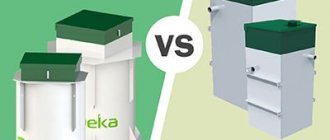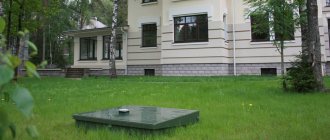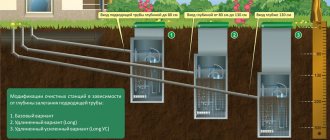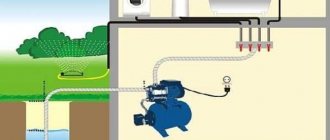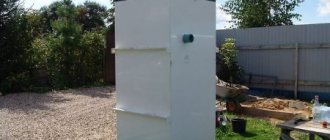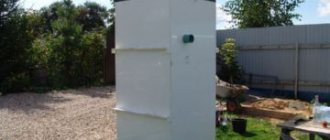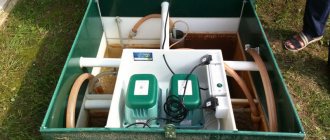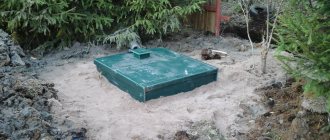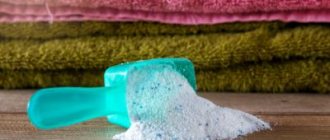Recommended articles:
Types of septic tanks for TOPAS dachas in combination with other systems What to choose TOPAS or UNILOS ASTRA? TOPAS septic tank with high groundwater Where to install a TOPAS septic tank on the site? DIY TOPAS maintenance
When installing a septic tank such as topas (based on the aeration principle), the question often arises: what can be poured into the septic tank, what is not desirable and what is strictly prohibited?
Aeration units operate on the principle of saturating water with air. Air bubbles do not allow the drain to settle, constantly mixing it due to aeration. Oxygen-saturated drainage allows for rapid growth of aerobic bacteria or otherwise activated sludge. Bacteria decompose and process the waste water entering the septic tank. As a result, at the outlet of the septic tank, clarified (purified) water with the smallest particles is obtained, suitable for watering trees or lawns and has no odor.
It is strictly forbidden to drain the following into a septic tank:
- Chlorine-containing detergents, such as Domestos, whiteness, toilet duck, etc.
- Alkalis and alkalis containing substances (mole, tyret, shumanite, laundry soap)
- Harsh disinfecting chemicals, antibiotics and drugs
- Mushrooms and mushroom waste - cleaning from them and even water are dangerous - a huge number of spores entering the septic tank begin the rapid development of mucus, which clogs the tubes and covers all surfaces with a layer.
- Discharge from filters for water purification (containing manganese, potassium salts, etc.)
All this, at a minimum, can lead to a malfunction of the station and the appearance of an odor, and, at maximum, to the need to pump out and restart the equipment. In these cases, it is recommended to drain these components bypassing the septic tank.
What paper is needed for a septic tank
Summarizing all of the above, we can say that if a septic tank with active cleaning is used as a treatment station, then you can throw any toilet paper into it. Simpler models will not cope with its disposal and may become tightly clogged. Therefore, it is better to use paper that was created specifically for septic tanks.
On a note!!!
Toilet paper is made from cellulose, it has strong fibers that do not dissolve in water! And all the manufacturers’ talk about how their products dissolve without residue is a marketing ploy. Once in the water, it will simply disintegrate into fibers and in this form will travel further through the sewer system.
The use of special paper eliminates the risk of blockages in the pipes and any septic tank can easily cope with it. However, this hygiene product has a significant drawback - its high price. The cost of special water-soluble paper is an order of magnitude higher than ordinary paper, for example, a package of 4 rolls of popular Aqua Soft paper costs 350 - 450 rubles. Of course, this is somewhat expensive, but on the other hand, repairing the installation will cost more.
Methods for recycling water from a septic tank
- Filter (drainage) well for an autonomous sewer system
It collects wastewater, it is filtered, passing through the drainage layer, and absorbed into the ground. This solution is optimal in cases where the soil on your site drains water well, for example on sandy soils.
If the soil is dense and heavy, for example clay or loam, it will not be possible to equip a drainage well.
It is important that the inlet pipe of the well is below the freezing level of the soil. The bottom of the well should be 0.5 m higher than the groundwater level. Otherwise, during the winter season, as well as during spring floods, runoff will linger in the reservoir.
According to SanPiN standards, the minimum distance from a septic tank to a well or well should be 50 meters, and to a cottage - 4 meters.
You can make a drainage well with your own hands or buy a factory-made product.
If storage septic tanks or rings are equipped, that is, flow-through treatment facilities, the drainage well will function normally for 3–10 years, it all depends on how actively it is used. After this time, the drainage pad will have to be replaced.
- Filter fields
Such drainage fields are suitable if you have a septic tank with 2-3 chambers and soil purification is required. This method is used when the groundwater level is quite low - less than 150 cm from the surface. The filtration field should be located at a great distance from the well and the house.
To equip the field, perforated pipes are used; they are mounted on a drainage layer of sand (10 cm) and crushed stone (40 cm). Then the system is hidden underground, the thickness of the backfill is 30 cm.
The filtration field will operate for 3–7 years depending on the composition of the wastewater. When the drains are oily, the system will have to be replaced more quickly.
- Storage well
Compared to a drainage tank, a storage tank is made in the form of a sealed tank. Wastewater and sludge are disposed of in it, even if the groundwater level is high.
In what situations is it permissible to equip a storage well:
- the volume of wastewater is too large, the soil does not have time to absorb the liquid;
- The water level is high, and wastewater cannot be discharged into a roadside ditch or behind a fence.
The storage well can be brick, concrete, metal or made of concrete rings. Factory-made plastic products, for example Rostock, are also sold.
This is interesting!
Aerobic septic tanks: pros and cons of operation Read more
Since plastic containers are chemically resistant, they are the most popular. Compared to other tanks, plastic containers do not need to be waterproofed.
You can also install a storage well made of metal, but over time it will become covered with rust.
Some home owners equip a storage well from reinforced concrete rings and bricks. However, such an installation will have to be waterproofed. The cost of setting up such a system is quite high, and it will have to be updated regularly.
Important!
The discharge pipe must be located at an angle so that the wastewater moves by gravity. When the slope is negative relative to the tank, it is necessary to install a pump to force the discharge of wastewater from the septic tank.
- Filter cassettes
This type of filtration is the most expensive and labor intensive. It works on the principle of filtering fields.
The cassettes contain pipes through which wastewater passes. In this case, the cassettes are protected by sealed walls and a lid. The cassettes purify wastewater when VOCs are found in clay soils that do not drain well.
To correctly determine the area, you should contact specialists who know the soil characteristics in your area. Typically, if 3 people live in a house, the filtration area will be 12 m2 on loamy soil, and 15–18 m2 on clay soil.
Cassette filters can purify wastewater up to 95–98%, but you will have to spend a large sum on equipment of such a design.
- Drainage tunnels
They are made in the form of a bottomless tank, the shape of which resembles an inverted trough with solid or perforated walls. Such tunnels are most often made of polyethylene or polypropylene, since these materials are the most durable and reliable. What are the advantages of drainage tunnels:
- capable of purifying large volumes of wastewater;
- compact, does not require a large area for installation, as is the case with filtration fields;
- It is possible to make drainage of the required volume. Due to the design features, the elements are connected to each other both in series and in parallel;
- The system is installed in the same way as filtration fields. But if you have a model with smooth walls, you will have to fill the top and sides with sand.
- Storm drain
Through the storm drain, wastewater flows away by gravity. Such a system is installed in cases where it is impossible to make a drainage well. You can make a storm drain yourself. You will need trays, as well as pipes of a suitable diameter.
It is important that the drain slope angle is selected correctly. Otherwise you will have to connect the pump.
At the end point of the storm drain there is a drainage well, where wastewater is purified and absorbed into the ground. However, this solution is suitable if you have installed a bioseptic tank that can purify wastewater by 95–98%.
;
Septic tank
Did you find this article helpful? Share it with your friends:
"White list" of some funds
Cleaning and detergents do not contain chlorine, aggressive surfactants, phosphates, toxic dyes, fragrances or dangerous preservatives. Using only natural active ingredients, surfactants from plants.
| Manufacturer | Product Name |
| Ecover (Germany, Belgium) | Washing powder without phosphates, "Ecover", 1200 g and 2650 g. Liquid detergent "Ecover" for washing wool and silk, 1 l Liquid detergent "Ecover" for washing, 1.5 l. Softener "Ecover" for laundry (conditioner) Floral, 1 l. "Ecover" fabric softener (conditioner) Solar, 1 l. "Ecover" fabric bleach, 400 g. "Ecover" stain remover, 200 ml. Ecological spray for cleaning all surfaces “Ecover”, 500 ml Ecological creamy cleaner “Ecover”, 500 ml Ecological cleaner “Ecover” for cleaning windows and glass surfaces, 500 ml Ecological cleaner for plumbing fixtures Ocean freshness “Ecover”, 750 ml Ecological cleaner for cleaning plumbing fixtures with pine aroma “Ecover”, 750 ml Ecological dishwashing liquid with grapefruit and green tea “Ecover”, 500 ml Ecological dishwashing liquid with lemon and aloe vera “Ecover”, 500 ml Ecological tablets for the dishwasher “Ecover”. Packaging: 500 g or 25 tablets |
| Frosch (Germany) | FROSCH Laundry detergent concentrate Ultra/Citrus FROSCH Washing gel with Aloe VeraFROSCH Fabric softener “Freshness” 750 ml FROSCH Stain remover gel with active oxygen 975 mlFROSCH Universal cleaner Lavender 1 l FROSCH Universal cleaner Lime 1 l FROSCH / FROSH Toilet bowl cleaner with lavender extracts 750 ml FROSCH / FROSH Toilet bowl cleaner with lemon extract 750 ml FROSCH / FROSH Vital Vitamin dish balm FROSCH / FROSH Cleansing Balm-Gel for dishes Citrus 500 ml, 750 ml FROSCH / FROSH Tablets for dishwashers “All in one” Soda |
| AlmaWin (Germany) | Phosphate-free washing powder ALMAVIN, BIO 1.08 kg Liquid detergent ALMAVIN for washing wool and silk, BIO 0.75 l Bile soap ALMAVIN for removing stains, BIO 0.1 kg Cleaning agent ALMAVIN with orange oil, 0.5 l Cleaning agent ALMAVIN for glass and mirrors, 500 ml. Environmentally friendly cleaner ALMAVIN for toilet bowls, 0.5 l. ALMAVIN detergent for manual dishwashing, 0.5 l. ALMAVIN tablets for dishwasher, 25 pcs. |
| KIILTO (Finland) | Ready-made product KIILTO Milki for removing limescale spray, 0.5 l Ecological cleaning product KIILTO Koti Eki for cleaning rooms and washing carpets, 1 l Kiilto WC-PUHDISTAJA SPRAY spray for eliminating unpleasant odors in the toilet, Lavender 0.5 l KIILTO Asteri dishwashing detergent, 1 l |
| Klar (Germany) | CLAR SOAP NUT WASHING LIQUID FOR COLORED AND WHITE LINEN HYPOALLERGENIC 125 ML KLAR HYPOALLERGENIC LIQUID FOR WASHING COLORED LAUNDRY KLAR WASHING POWDER CONCENTRATE FOR COLORED LAUNDRY HYPOALLERGENIC ETC. https://www.eco-tut.ru |
| Sonett (Germany) |
https://www.biogradproduct.ru/sonett-produce |
| EcoLife | washing probiotics https://www.ecolife.zp.ua |
| ECODOO (France) |
https://www.naturworld.ru/catalog/brands/detail.php?MANUFACTURER=1551 |
| CHRISAL (Belgium) | CHRISAL detergents are aqueous solutions of organic compounds. The products do not contain such aggressive inclusions as chlorine, phosphates, phthalates, optical brighteners, weakly biodegradable surfactants, and organic acids. https://www.chrisal-product.ru |
| Aqualon (Aqualon, Russia) | Not all products are biodegradable, but some are:
|
| Chistown (Eurasian Soap Company LLC, Russia, Rostov-on-Don) | The products do not contain phosphates, chlorine, zeolites, a-surfactants and other toxic substances; made from natural raw materials; contain more than 30% natural soap based on vegetable fats. Almost completely biodegradable https://chistown.ru |
| Ecomax (Asia, part of eCosway) |
https://alzal-ecosw.ru/production/bytovaya-khimiya |
| Faith in nature (UK) |
Without SLS/SLES, parabens, etc., natural composition (almost entirely plant-based). In the soap description: “suitable for autonomous cleaning systems, septic tanks, etc.; The product is quickly and completely biodegradable.” https://www.sver4ok.ru/page/faith-in-nature.html |
| Garden |
“...environmentally friendly and safe for humans and the environment:... 100% natural ingredients; ...DOES NOT contain phosphates, optical brighteners, aggressive surfactants, zeolites, silicates, dyes, petroleum products, or other toxic substances and is safe to use; ...does not cause allergies or skin irritation; ...completely biodegradable in nature; Does not harm the environment and water sources; water after use is suitable for watering the garden https://my-shop.ru/shop/products/1771763.html |
| iHerb | https://ru.iherb.com/Laundry-Detergent |
| SSHerbals (India) | soap nuts
https://www.biobrands.ru/brands/ss-herbals.html |
| Tierra Verde, SRO (Yellow&Blue) (Czech Republic) | soap tree fruit
https://eshop.tierraverde.cz |
Topas in winter
In general, the Topas septic tank in winter is designed for the same operation as in the warm season. However, any facility can operate seasonally. When interacting with the client, specialists immediately explain whether it is possible to turn off the Topas septic tank for the winter and how to do it correctly. As stated in the paragraph above, the Topas septic tank is disconnected from the power supply in winter, cleaned of sludge, partially filled with water and left in this state for a certain period. There is no need to turn off Topas in winter if it is rarely used. Even if the sewage system is used at the dacha on weekends, such drainage of sewage is enough to prevent Topas from freezing.
Topas surfaced
This situation is a problem for installers. Perhaps the container was not properly filled with water, as required by the installation technology. Or when filling the space between the walls of the pit and the walls of the septic tank body, the sand is poorly compacted. It is also possible that the top filling was done incorrectly - the sand on top should be covered with soil that does not allow water to pass through well. Such defects will definitely make themselves felt if a high water level is recorded in the soil - it is important to install the Topas correctly. If you don’t want to have problems like this, order VOC installation from.
Do I need to clean the Topas septic tank?
Even with a very careful attitude to the use of sewerage, without routine maintenance, after a while, cloudy water will appear at the outlet of Topas. This is explained by untimely pumping of sedimentary sludge from the septic tank chambers. Why does sludge form in Topas? During the purification technology, insoluble contaminants are released from the water, which after sedimentation must be removed after a certain period of time.
If you want to know more about the operating features of the treatment plant, contact the contact line. You are guaranteed to receive professional help quickly and inexpensively at any time of the year.
What should not be thrown into the cesspool
Most often, blockages do not appear at the moment when we pour products into the sewer that were not intended for this purpose. Deposits and growths accumulate for months. Hoping that the blockage will not manifest itself is stupid. A negligent attitude towards sewerage leads to problems that are extremely difficult to eliminate.
Prevent the following items and products from getting into the cesspool.
Cat litter
By absorbing moisture, the composition increases in volume many times over. A large lump forms in the pipe. The filler granules get wet and become viscous. The chances that such a mass will be washed away by a stream of water are minimal.
Hygiene products
Baby diapers, feminine pads and tampons, makeup sponges, paper towels. Despite the fact that the components from which they are made quickly decompose, upon contact with water they clog pipes and simply increase in size.
